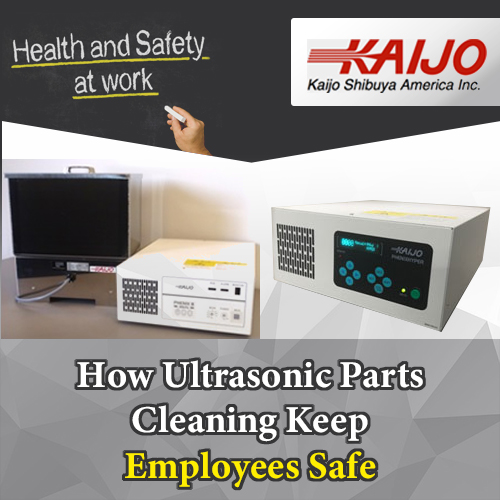How Ultrasonic Parts Cleaners Keep Employees Safe
November 5, 2019
 Contrary to traditional cleaning methods that require extensive handling of parts, scrubbing them and soaking them in harsh chemicals, ultrasonic cleaning lets workers place the parts in a water-based solution and leave them there for a short period until they are clean. With ultrasonic parts cleaners, employees are safe from accidents involving sharp part edges or pointy cleaning tools. Their health doesn’t suffer from exposure to toxic chemicals and fumes. Ultrasonic cleaning systems don’t introduce any hazards into the workplace and their use greatly increases employee safety.
Contrary to traditional cleaning methods that require extensive handling of parts, scrubbing them and soaking them in harsh chemicals, ultrasonic cleaning lets workers place the parts in a water-based solution and leave them there for a short period until they are clean. With ultrasonic parts cleaners, employees are safe from accidents involving sharp part edges or pointy cleaning tools. Their health doesn’t suffer from exposure to toxic chemicals and fumes. Ultrasonic cleaning systems don’t introduce any hazards into the workplace and their use greatly increases employee safety.
Less Handling of Parts Reduces Accidents
Traditional cleaning of parts is labor-intensive. While machines can remove some of the dirt, many parts have complex shapes that require visual inspection and manual scrubbing and scraping to get the part completely clean. The handling of heavy parts or of parts with sharp edges and corners can result in strain, cuts and bruises. Employees have to be careful and this manual mechanical cleaning can be very time-consuming. Ultrasonic cleaning reduces handling of parts and the risk of accidents.
Sharp Tools Can Injure Employees
Heavily contaminated parts often require brushing and scraping to remove all contaminants from the parts. Wire brushes have sharp bristles that can penetrate gloves and lodge under the skin of fingers and palms. Scrapers have to be sharp to effectively remove caked and ground in dirt but the sharp edges can cut through protective clothing to injure employees. Ultrasonic cleaners work without brushing or scraping tools and their use avoids this kind of injury completely.
Harsh Chemicals Can Affect Employee Health
Safety hazards from the use of toxic chemicals and solvents come from the storage and handling of the chemicals, their use during cleaning of the parts and their disposal. The solvents used during traditional cleaning have to be received from the supplier, stored until required and delivered to the chemical bath for soaking the parts. Each of these procedures risks exposing employees to chemical flows and spills that can affect their health.
Use of the chemicals for soaking the parts exposes employees to fumes and contact with the chemicals when parts are placed in the soaking tank. Once the soaking process is complete, the solvents have to be neutralized with additional chemicals so they can be released without damaging the environment. Even when highly automated, the workplace remains dangerous to employees with the presence of several types of hazardous chemicals. Ultrasonic cleaning requires no special solvents beyond mild detergents in a water solution for heavy contamination with grease or oily deposits. These detergents are not hazardous and no special disposal procedures are required.
Ultrasonic Parts Cleaners Work Safely, Quickly and Effectively
Ultrasonic parts cleaners work by creating microscopic cavitation bubbles in the cleaning solution. The formation and collapse of the bubbles scrub parts surfaces and dislodge dirt and contaminants. Heat and a mild detergent can speed up the removal of some substances but no major sources of safety and health hazards are present. The employees can simply place the parts to be cleaned in the ultrasonic cleaning tanks, switch on the cleaner and set a timer. The process works independently without supervision and involves no dangerous procedures.
Kaijo has a complete line of ultrasonic parts cleaners and offers free consulting to help customers select the best system for their application. As a leading supplier of ultrasonic cleaning equipment, Kaijo manufactures state-of-the-art ultrasonic generators, transducers and cleaning tanks as well as turnkey systems. With lengthy experience and extensive in house expertise, the company can help ensure that the ultrasonic parts cleaners it supplies deliver the expected performance. Call Kaijo for a free consultation to discuss your specific cleaning application requirements.





